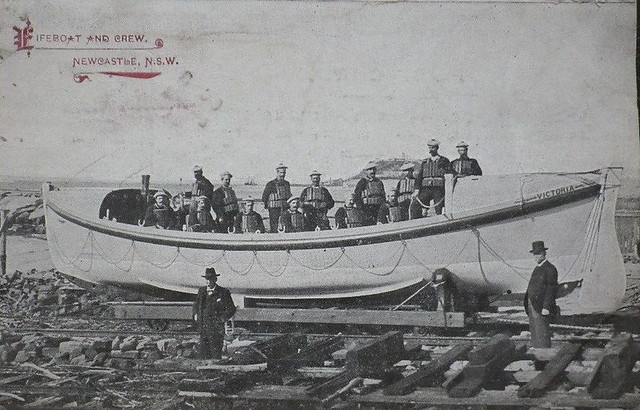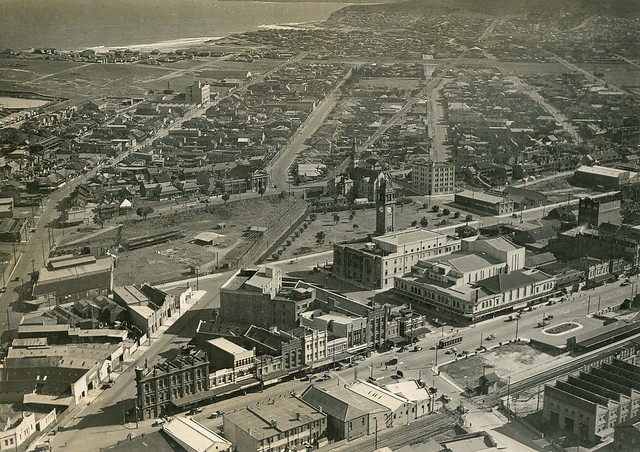As the second-largest city in New South Wales and the sixth-largest in Australia, Newcastle is located 162 kilometres north-northeast of Sydney, at the mouth of the Hunter River.
Awabakal People
The Newcastle CBD area was called
Mulubinba by the Awabakal people. Their traditional territory spread from Wollombi in the south to the Lower Hunter River
near Newcastle and Lake Macquarie in the north. {It should be noted, however, that, John Fraser (1834 – 1904), an Australian ethnologist, linguist and school headmaster actually created the term "Awabakal" for the coastal Aboriginal people.}
The Awabakal people were encircled to the north–west by the Wonnarua people, the Worimi to the north–east, and the Darkinjung peoples to the west and south.
The name "Awabakal" means people of the plain or flat surface; believed to refer to the surface of Lake Macquarie.
When Lieutenant Grant made his expedition to the Hunter River in 1801, the large quantity of oyster shell middens (remains of shellfish meals) along the Hunter River was remarked upon. The sand along the Hunter
River foreshore was also used by the Awabakal people for burial. Other observations were made about the Aboriginal people.
The first missionary to Aboriginal peoples, L.E. Threlkeld, who worked with the Awabakal people, expressed how
a beached whale was cause for a feast, He said: "A whale cast on shore, is a feast, and messengers are dispatched to all the neighbouring "tribes", who assemble and feast upon the monster of the deep so long as the treat lasts". (Threlkeld stayed sixteen months in Newcastle)
Threlkeld (Umwelt 2009) stated that Aboriginal people were ‘employed’ in
the Newcastle settlement as fishermen, water carriers, messengers, servants and on board ships
Threlkeld also said that Aboriginal people were “employed” in the Newcastle settlement as fishermen,
water carriers, messengers, servants and on ships. Many, however, died from diseases to which they had no immunity and others were displaced.
In 1826, Threlkeld moved to his Mission at Bah-ta-bah, present-day Belmont (perhaps on the comer of Gen Street and the Pacific Highway). He wrote: "I looked at the state of the blacks; I took up my residence in the wood, determined, if possible, to
obtain a knowledge of the aborigines, leaving the event with the hands of Him who overrules all things for the good of those who love him".
From 1825, Biraban, a leader of the Awabakal people assisted Threlkeld, teaching him the Awabakal language and beliefs. Before his Awabakal initiation, Biraban was named We-pohng.
“Birabahn” is the traditional name of the eagle-hawk totem for Awabakal people.
 |
| A portrait of Biraban, from L. E. Threlkeld's book A Key to the Structure of the Aboriginal Language, published in 1850. |
 |
| "Lower Macquarie Tribe", New South Wales Aborigines. (1898, December 3). Australian Town and Country Journal |
A newspaper article published in 1934 recounts
some reminiscences of Mrs Farnham living at Holland-street, Wickham. In about 1852, at the age of 10 years, Mrs Farnham recalled seeing an Aboriginal corroboree. (
1.)
Historic Fishing Tree
 |
| The Fishing Tree was used by generations of Worimi (a collective denominator of the Awabakal and several other tribes) people to find schools of fish near Bagnall's Beach |
The Fishing Tree, which can be viewed at the Newcastle Museum, is estimated to have lived for 300 to 400 years until vandals burnt it in 2001. The tree was used by the Worimi people near Bagnall's Beach to find the best fishing spots. Footholds along the tree trunk
allowed a person to climb out over the water and see where the fish were.
 |
| Corroboree at Newcastle, circa 1818, Joseph Lycett |
 |
| Painting of Aboriginal people of the Newcastle area by James Wallis, c1818 |
Captain James Cook
Captain James Cook first noted Nobbys Head (Aboriginal: Whibayganba) on his expedition along the east coast of Australia in May 1770.
 |
| Australasian (Melbourne, Vic. : 1864 - 1946), Thursday 18 October 1934 |
 |
| Drawing of The Endeavour |
 |
| Painting of Nobbys Head, Newcastle, NSW |
Lieutenant John Shortland explored the Newcastle area in 1797, whilst searching for five escaped convicts. As Shortland headed
back toward home, having left the Port Stephens area, where the search for the convicts was unsuccessful, he came across "a very fine coal river", which he named after Governor Hunter.
 |
| Daily Telegraph (Sydney, NSW : 1931 - 1954), Monday 1 September 1947 |
Coal River
On returning to Sydney Cove, Lieutenant Shortland took a drawing of the Newcastle area and reports of coal deposits. Over the next two years, several ships sailed to Coal River (Newcastle) to pick up coal and by 1799, there was enough coal to make up a shipment for export to Bengal. This is believed to be Australia's first commodity export.
The first coal was extracted from "Colliers Point", at the base of "Signal Hill", which today known as "Fort Scratchley".
.jpg) |
| Three-masted barque at anchor in Newcastle, New South Wales, n.d. Samuel J. Hood Studio Collection |
The colonial authorities at Sydney Cove decided that the discovery of the coal resources would enable the fledgeling British settlement to become more self-sufficient.
Lieutenant Charles A. F. N. Menzies of the Royal Marines was appointed on 15th March 1804, to command and superintend the settlement of Newcastle. This commission was signed by Philip Gidley King, Governor of the Colony of New South Wales.
The Convict Era
On March 27 1804, three ships: the
Lady Nelson, the
Resource and the
James arrived at Newcastle with convicts and a military guard.
Newcastle was simply known as "The Camp", for many years. Also "Coal River" and "Kingstown".
For twenty years, Newcastle remained a penal settlement with a harsh reputation for brutality. This reputation was well-deserved; especially, Limeburners' Bay, on the inner side of Stockton peninsula (Scott's Town), where the most hardened convicts
were sent to burn oyster shells for making lime.
NEWCASTLE IN 1818.
A GRIM PICTURE
A newspaper article from 1936 shows excerpts from letters by John Slater, a
silk weaver from Nottingham, who was transported to the colonies as a convict.
"I shall endeavor to explain in what
manner the misery it is intended they
should bear is extended to them. On
their landing at Newcastle both legs
are put in irons, and they are set to
work in the coalmines and about the
lime kilns, and are looked after with
the strictest scrutiny. A man at this
place cannot earn anything by labour,
as all the work is on account of the
Government, and thus solely depend
ing on bis meat and flour, out of which
he has to defray his lodging, washing
etc., he is reduced to the lowest state |
of indigence and poverty which man
can possibly bear and in which I should
fall short in the expression of . . . !"The Henty Observer and Culcairn Shire Register (NSW : 1914 - 1950) Fri 11 Sep 1936 Convict Days
Mrs Farnham, the elderly woman mentioned above (of Wickham),
"graphically described her first sight of convicts. She was only a child then, but can remember seeing the manner in which the un-fotunates were treated. Her mother often told her of the life they led. They were yoked up in gangs, and had to build roads with gravel procured from the river. If they answered back, or even murmured, they were subjected to the fury of the wardens, who thrashed them with those long lashes...." (
2.)
 |
| Newcastle Harbour from Fort Scratchley, circa 1890 |
James Hardy Vaux
The English-born convict, transported to Australia on three separate occasions, James Hardy Vaux, arrived in 1811, at the Newcastle penal
settlement, for receiving stolen property. In 1814 Vaux was caught attempting to escape the colony by ship. As punishment, he was flogged and returned to Newcastle.
Vaux is worthy of mention because he wrote two books whilst he was living at Newcastle. The first was a dictionary of "flash" or cant language, which would later be called:
James Hardy Vaux's 1819 Dictionary of Criminal Slang. The other book was titled:
Memoirs of the First Thirty-Two Years of The Life of James Hardy Vaux, A Swindler and Pickpocket; Now Transported for the Second Time, and For Life, to New South Wales. See
here
 |
| Portrait of James Hardy Vaux. Originally published in Knapp & Baldwin's, New Newgate Calendar, 1825 |
Commandant of Newcastle
Captain James Wallis was the commandant of Newcastle from 1815 to 1818, and under his charge, not only did the convicts' conditions improve, but the plan of a town was laid out and building began in earnest.
While
in command at Newcastle, Wallis encountered the convict artists, Joseph Lycett and Richard Browne. Wallis encouraged the artists to paint the land and the Aboriginal people of the region.
 |
| Cobbawn Wogi Native Chief of Ashe Island Hunters [sic] River N S Wales, 1819 / drawn by R. Browne, Mitchell Library, State Library of New South Wales |
An Anglican Church was built in 1817 on the site where Christ Church Cathedral stands today. The town's first gaol was constructed in the Georgian style, between 1816 to 1818, on a site overlooking the ocean, high above Newcastle beach.
Australia's oldest public school was built in East Newcastle in 1816. The impressive Gothic building that now stands was built in 1878.
A Commissariat Store was constructed on Watt Street in 1818.
Governor Macquarie mentions that "Burigon King of the Newcastle native tribe" performed (with others) a corroboree outside government house at Newcastle on the evening of 6 August 1818.
The Bogey Hole, also known as the Commandant's Baths, located at the foot of "sheep pasturage hill", was constructed by order of Commandant Morisset in about 1820 for personal use.
A Newcastle Female Factory also operated in the region as a depot for the assignment of convict women in the Hunter Valley region and as a punishment centre for women who rebelled against the system.
Newcastle closed as a penal settlement in 1822. However, in 1832, the Lumber Yard reopened as a base for convicts building Nobby's breakwater, known as "The Stockade". The eastern side of the settlement was mostly used as a Government Farm.
In 1825, 10,000 acres near Lake Macquarie were set aside for an Aboriginal settlement.
The first Newcastle post office
was built in 1828 at the "Sessions House", on the corner of George Street (today known as Watt Street) and Church Street, Newcastle.
 |
| Panorama of Newcastle : watercolour drawings attributed to Edward Close, 1821, SLNSW |
Transportation of convicts to NSW stopped in 1840.
Newcastle Government House and Domain was completed in 1842. The official residence was later used as a psychiatric hospital at 72 Watt Street.
 |
| The former convict lumber yard was located here at 98 Scott Street |
 |
| Former Newcastle Government House is a heritage-listed former military post and official residence and now park and psychiatric hospital at 72 Watt Street, Newcastle, NSW (completed 1842) |
Free Settlers and Industry
The military rule of Newcastle ended in 1823, with most of the convicts being sent to Port Macquarie.
Free settlers then began to arrive at Newcastle in droves, to work in the coal mines and at other trades.
Wickham was the first area opened up in the 1840s, with land grants to settlers. Followed by Waratah, the first land grant to John L. Platt and later, the Waratah Colliery came into existence in 1843. Lambton developed fast with the Lambton Colliery in 1862. Hamilton, originally called Pitt Town, was where the miners lived.
The Dangar family established Newcastle's first cannery on the harbour foreshore in 1848.
Later, Newcastle had a copper smelting works and a large and successful soap factory. The BHP steelworks would arrive in 1915 to shape the character of the town until its closure in 1999.
Newcastle was connected with Sydney by telegraph in 1860.
 |
| View of Newcastle, N.S.W. From Church-Street, looking N.E., showing the entrance of habour, 1860-1890? SLVIC |
 |
| View of Newcastle, NSW, between 1860 and 1890?, SLVIC |
1870s
Port Scratchly was built as the result of an invasion scare by the Russians following a visit by three
Russian warships to Hobart in 1873. The warships lay in the harbour for three days obviously taking soundings, regardless of inquiries of port officials and residents.
here
1880s
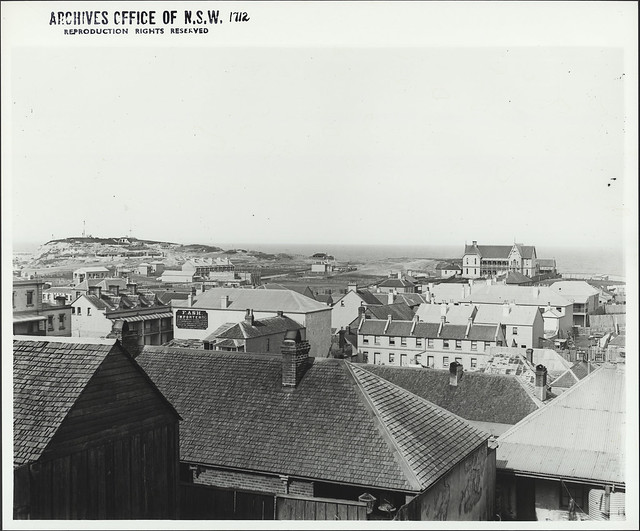 |
| View over Newcastle looking towards Flagstaff Hill and Newcastle Beach, circa 1882-1884. Public Domain |
 |
| Carriage builders, Honeysuckle railway sheds, Newcastle, NSW, April 1886, Special Collections |
 |
| The ship "Duke of Buccleuch", Newcastle NSW, 1886, Special Collections |
 |
| Fort Scratchley, Newcastle, NSW, [c1888], Special Collections |
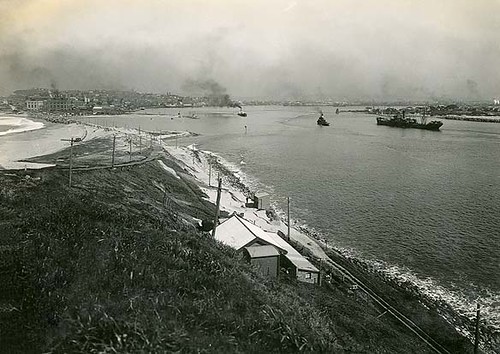 |
| View of the entrance to Newcastle Harbour, Newcastle. n.d NSW State Archives |
1890s
Newcastle Boatmen
In the 1890s, the NSW Government employed 22 boatmen to assist boats that were in distress in the Newcastle Harbour. The men and their families were provided houses near the harbour. These wonderful, circa 1892 terraces on Nobbys Road, Newcastle East, were sold off by the government and they are now in private ownership.
 |
| Boatmen's Row terraces were built to house the boatmen who saved people off shipwrecks, built 1890 |
 |
| Wolfe Street, Newcastle, NSW, [1890], Special Collections |
 |
| Lambton Park & Council Chambers, Lambton, NSW, 9 September 1890, Special Collections |
 |
| Tighes Hill Fire Brigade, [Newcastle, NSW], 24 October 1896, Special Collections |
 |
| Scott The Draper, 12 Church Street, Newcastle, NSW, Sydney Mail and New South Wales Advertiser (NSW : 1871 - 1912), Saturday 18 September 1897 |
 |
| The Waratah Benevolent Asylum and Lying-In Hospital opened in May 1897. Sydney Mail and New South Wales Advertiser (NSW : 1871 - 1912), Saturday 18 September 1897 |
 |
| Medical and nursing staff, Newcastle Hospital, NSW, Sydney Mail and New South Wales Advertiser (NSW : 1871 - 1912), Saturday 18 September 1897 |
 |
| Lord Beauchamp at Newcastle. The Honeysuckle Point Railway Workshops were designed by John Whitton and built from 1874 to 1886Sydney Mail and New South Wales Advertiser (NSW : 1871 - 1912), Saturday 23 December 1899 |
 |
| Scene at Queen's Wharf, Newcastle, NSW. Military contingent for active service departing for South Africa, Sydney Mail and New South Wales Advertiser (NSW : 1871 - 1912), Saturday 18 November 1899 |
 |
| Scene at Queen's Wharf, Newcastle, NSW. Military contingent for active service departing for South Africa, Sydney Mail and New South Wales Advertiser (NSW : 1871 - 1912), Saturday 18 November 1899 |
 |
| Scott Street, Newcastle, NSW, Sydney Mail and New South Wales Advertiser (NSW : 1871 - 1912), Saturday 23 December 1899 |
 |
| Hunter Street east, Newcastle, NSW, Sydney Mail and New South Wales Advertiser (NSW : 1871 - 1912), Saturday 23 December 1899 |
 |
| Wolf Street from Church Street, newcastle, NSW, Sydney Mail and New South Wales Advertiser (NSW : 1871 - 1912), Saturday 23 December 1899 |
 |
| Pay day at the A Pit Colliery Office, Newcastle, NSW, 24 February 1899, Special Collections |
 |
| A Pit Colliery, Newcastle, NSW, 24 February 1899, Special Collections |
A Famous Visitor
Mark Twain (aka Samuel L. Clemens), the noted American author and humorist, visited Newcastle in 1895, arriving by train from Sydney. He observed that: "Newcastle consists of a long street with a graveyard at one end with no bodies in it, and a gentleman's club at the other with no gentlemen in it”.
An Industrious Town
 |
| Newcastle Morning Herald and Miners' Advocate (NSW : 1876 - 1954), Wednesday 20 January 1897 |
1900s
 |
| Tram in operation - Scott Street, Newcastle, NSW, NSW State Archives, 1900 |
 |
| Miners going to work, Newcastle NSW, Australasian (Melbourne, Vic. : 1864 - 1946), Saturday 14 July 1900 |
.jpg) |
Hunter Street, Newcastle, NSW, 1st January 1900
|
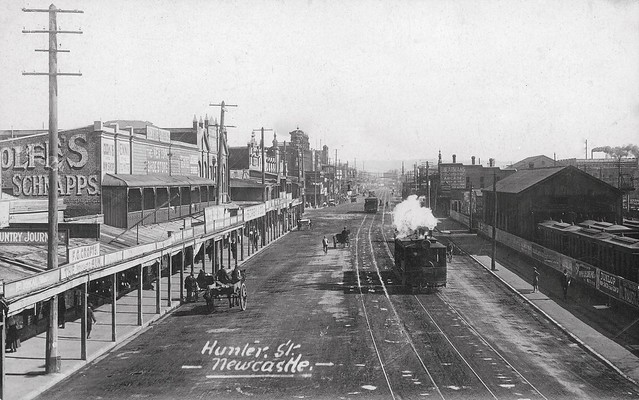 |
Newcastle, NSW, circa 1900, Looking towards the Darby Street intersection.
Newcastle Stories |
A new post office building was constructed on the corner of Bolton and Hunter Streets in 1903. This was formerly the site of the Court House.
 |
| Newcastle's post office openied in 1903, NSW, Sydney Mail and New South Wales Advertiser (NSW : 1871 - 1912), Wednesday 12 August 1903 |
The sailing ship, Adolphe, was wrecked at the mouth of the Hunter River in 1904. The ship is now the most prominent of several wrecks on what is now the Stockton breakwall.
 |
| This slide depicts the wreck of the Adolphe as photographed on 30 September 1904. You can also see the mast of the shipwreck Regent Murray in this photo. From the University of Newcastle Library's Cultural Collections |
 |
| Hunter Street, Newcastle, New South Wales. The premises of William Dombkins, boot manufacturer, can be seen on the right. Circa 1905 |
 |
| Perkins Street, Newcastle, NSW, [1905], Special Collections |
 |
| Carrington Street, West Wallsend, NSW, 17 April 1906, Special Collections |
 |
| David Cohen & Co. Warehouse is a heritage-listed facade and side wall from a former warehouse at 48-50 Bolton Street, Newcastle, NSW, Sydney Mail and New South Wales Advertiser (NSW : 1871 - 1912), Wednesday 18 August 1909 |
 |
| David Cohen & Co. Warehouse is a heritage-listed facade and side wall from a former warehouse at 48-50 Bolton Street, Newcastle, NSW, Sydney Mail and New South Wales Advertiser (NSW : 1871 - 1912), Wednesday 18 August 1909 |
 |
| School displays for Empire Day, Newcastle Showground, Broadmeadow, NSW, 25 May 1910, Special Collections |
 |
| Newcastle Beach and promenade, Newcastle, NSW, 12 February 1912, Special Collections |
 |
8 Hour Day Procession in Hunter Street, Newcastle, NSW, 1913
|
WWI
 |
| David Gordon Ramsay, Date of Birth: 21.4.1899, Date of Enlistment: 5.4.1918, Trade or Calling: Clerk, Born in or near what Town: Banff, Address prior to Enlistment: Perkins St Newcastle, Rank, Number, Battalion, Distinctions: Cpl, Recruits, Casualties and where: Name & Address of Next of Kin: as below Name and last address of Father: George Ramsay Newcastle, State Library of New South Wales |
 |
| Title: Blacksmiths shop, Walsh Island, Newcastle, NSW, Dated: February 1916, NSW State Archive |
 |
| Voice of the North (NSW : 1918 - 1933), Friday 10 October 1919 |
 |
| Marine Drive - Nobbys in background. Page 18, Newcastle - the tourist centre of the North, c. 1920s. Special Collections |
 |
| Workmen laying concrete paving, Hunter Street, Newcastle near the Hotel Rawson and premises of Dick Bath, ca. 1921, Sam Hood, State Library of New South Wales |
 |
NOTABLE ABORIGINE: Perpetuating Hunter River Identity's Memory A link with the past was broken when Tom Dillon died at Newcastle hospital recently at the age of 90 years "Old Tom' was a well-known flgure in Newcastle, and had many friends, who not only respected the flne old man. but had learned lo love him. Newcastle Sun (NSW : 1918 - 1954), Saturday 4 August 1923 |
 |
The Astoria Cafe was located in Hunter Street, Newcastle. Proprietor was Jerry Kolivas
Newcastle Morning Herald and Miners' Advocate (NSW : 1876 - 1954) Wed 24 Oct 1934 |
 |
| Football (Newcastle v Souths or Norths v Wests), 21/5/1935, by Sam Hood, State Library of New South Wales |
 |
Rugby League match at the Sportsground between Newcastle No. 1 and Coalfields No. 1. Newcastle Sun (NSW : 1918 - 1954), Tuesday 8 May 1934 |
 |
| The King and Queen, on the occasion of their visit to Newcastle during their Australian tour as the Duke and Duchess of York, leaving Newcastle station with the Mayor of the city at that time, Ald. R. Gibson.Newcastle Morning Herald and Miners' Advocate (NSW : 1876 - 1954), Tuesday 15 December 1936 |
In 1932 Australia's official unemployment level reached a peak of 32 per cent. Shanty towns sprung up around Newcastle.
 |
| Unemployed camps, Newcastle, NSW, Newcastle Morning Herald and Miners' Advocate (NSW : 1876 - 1954), Tuesday 26 May 1936 |
 |
| Coal mines: Newcastle District, circa 1937, State Archives & Records Authority of New South Wales |
 |
| Bon Ton Millinery, R. Whitaker Jeweller, Selfridges, Cooks Ham Shop, Resch's DA Dinner Ales, Hunter Street, Newcastle 1938, Special Collections |
 |
| Jenifer Keyes, Ladies' Hairdresser, abve Frances Ann Hunter St., Newcastle and Potter & Co., Watchmakers, Jewellers, and Opticians. 1938. Newcastle, NSW, Special Collections |
 |
Newcastle Morning Herald and Miners' Advocate (NSW : 1876 - 1954), Tuesday 20 June 1939
|
 |
| Six nurses lean over the balcony, Mater Hospital, Newcastle (for Building Publishing Co). February 1939, State Library of New South Wales |
1940s and WWII
The Shelling of Newcastle by the Japanese submarine I-21 occurred in the early hours of 8 June 1942. The bombardment followed the Attack on Sydney Harbour by three Japanese midget submarines on 31 May.
 |
| Members of the W.A.N.S. (above) and W.A.A.A.F. (below) in Ihe parade yesterday of Newcastle women's organisations, Newcastle Morning Herald and Miners' Advocate (NSW : 1876 - 1954), Monday 20 October 1941 |
 |
| Newcastle Sun (NSW : 1918 - 1954), Saturday 28 August 1943 |
 |
| Hartley Spurr arrived in Newcastle in 1883 and by the time Pix Magazine sent Ivan Ives to photograph his fishing bait shop he had been at this location for over fifty years. Wharf Road, Newcastle, New South Wales,. Taken on March 29, 1943. State Library of New South Wales |
 |
Lysaght's, Newcastle, NSW, circa 1944, State Archives of NSW
|
 |
| Newcastle Morning Herald and Miners' Advocate (NSW : 1876 - 1954), Tuesday 11 September 1945 |
 |
| Newcastle Morning Herald and Miners' Advocate (NSW : 1876 - 1954), Thursday 15 March 1945 |
 |
| Newcastle Morning Herald and Miners' Advocate (NSW : 1876 - 1954), Monday 2 December 1946 |
 |
| Power House and Yard from Customs House, Newcastle NSW. Dated: 26/06/1947, NSW State Archives |
 |
| RE-ENACTING THE LANDING of Lieutenant John Shortland at Port Hunter in 1797. Mr John Shortland (extreme right). Insurance clerk, of Manly — a descendant of Shortland—portrayed his ancestor. The ceremony was part of Newcastle's 150th Anniversary Celebrations, Daily Telegraph (Sydney, NSW : 1931 - 1954), Wednesday 10 September 1947 |
 |
| Title: Newcastle Station building exterior general view, Newcastle NSW. Dated: 13/08/1947, NSW State Archives |
 |
| Hunter Street, Newcastle, NSW, 1949 / photographer R. Bean, State Library of New South Wales |
"The New Australians"
After WWII, many migrants called "New Australians" began to arrive from countries like Greece and Italy to settle in Australia. The Newcastle suburb of Hamilton became a popular place for the Greek population to live and to start businesses and raise families. More
info |
| Migrants from Greta camp arrive at Civic Park for the Cultural Centre fair, Newcastle, New South Wales, 29 October 1949. National Library of Australia |
1950s
 |
| Royal visit of Queen Elizabeth II to Newcastle, NSW, 1954, File:SLNSW 32021 |
 |
| Traffic policeman on patrol duties. Hunter Street, looking west; Union Street junction, 1957, SLNSW 127446 |
 |
| Nobby's Beach, Newcastle, N.S.W. - 1950s, Aussie Mobs |

Traffic at junction of Hunter and Union Streets, Newcastle, NSW, circa 1957
1960s
 |
| Striking steelworker, Newcastle, NSW, Tribune (Sydney, NSW : 1939 - 1976), Wednesday 30 October 1963 |
 |
| Ron Morrison's classic photo of a bustling Hunter Street, 1968. British Leyland buses have replaced the trams. CC BY-SA 3.0 |
1970s
The Star Hotel riot occurred on the night of 19 September 1979, after the pub closed. This riot was one of the largest in Australian history,
with an estimated 4,000 people fighting police on the streets of Newcastle.
 |
| The lineup of competitors on Shortland Esplanade for the Newcastle Hillclimb at King Edward Park in 1971. Ken Hodge |
1980s
Fanny's Nightclub opened in 1984.
 |
| Argyle House was built in 1860 (Fanny's Tavern), Newcastle, NSW, Heritage Office, CC BY 4.0 |
The Newcastle earthquake occurred on Thursday, 28 December 1989 . About 50,000 buildings were damaged; about 80 percent of these were homes.
2019 |
| Newcastle Light Rail at Civic, Newcastle, NSW, MDRX |
Famous Artist: William Dobell
 |
| Self portrait of William Dobell at the Art Gallery of NSW |
Sir William Dobell OBE (1899- 1970) was born in the working class suburb of Cooks Hill, Newcastle, one of six children. After he left school he was apprenticed to a local architect to train as a draftsman, but Dobell later attended Julian Ashton’s Sydney Art School and became one of the greatest Australian portrait painters.
Heritage Lost
Back in the 1970s, the Newcastle Council removed and smashed up many old headstones from the grounds of Christ Church Cathedral, Newcastle, including the grave of my ancestor. It is claimed that many of the stones were broken and illegible.
Many of these headstones were taken to Blackbutt Reserve for use in retaining walls and edging. A council worker involved at the time said: ‘
‘Some stones were offered to anybody who wanted them, and I remember a lovely red granite one, belonging to a Clunes Innes, that was taken to Port Macquarie.’’
The Christ Church stones were used around many parts of Blackbutt Reserve, especially on the Carnley Avenue entrance walls.
 |
| Gravestones used as retaining walls at the Carnley Avenue entrance, Blackbutt Reserve, NSW |
 |
| Christchurch Cathedral, Newcastle, New South Wales, circa 1817 |
Street Names
The layout of the streets in Newcastle's central business district is called a Dangar Grid, named after its designer, Henry Dangar. Many of these streets are named after notable British engineers of the Industrial Age.
- Brown Street is named after Alexander Brown, Colliery Manager for the A. A. Co.
- Perkin Street (now Perkins Street) is named after Jacob Perkin, an engineer. He invented many machines, such as: machines for cutting and heading nails and steam power and refrigeration.
- Wolffe Street, then "Woolf Street" (now Wolfe Street), is named after Arthur Woolf, engineer. Most famous for inventing a high-pressure compound steam engine.
- Newcomen Street is named after Thomas Newcomen, mechanic, assembled the prototype for the first modern steam engine.
- Boulton Street (now Bolton Street) is named after Matthew Boulton, engineer. He financed and introduced James Watt's steam engine.
- Watt Street (first street in Newcastle, originally called High Street) renamed after James Watt, engineer and Scottish inventor renowned for his improvements in steam engine technology.
King Street, however, is named after the NSW Governor, Captain Philip Gidley King and
Church Street is in reference to the original Christ Church (now Cathedral), built in 1817.
Sadly, many of Newcastle's many wonderful buildings were damaged and even destroyed by the earthquake of 1989.
Around Newcastle
 |
| Fort Scratchley Newcastle, NSW, 1882. The guns at the fort fired upon a Japanese submarine which shelled the city in 1942. |
 |
| Newcastle Ocean Baths, circa 1922, Newcastle, NSW |
 |
| Miss Porter's House is a National Trust property in Newcastle built in 1909. uilt in 1909 Built by Herbert Porter, the terrace was home to the Porter family until 1997. The home was left to the National Trust by Miss Hazel Porter as a living home. Newcastle, NSW |
 |
Stegga's Emporium, built in 1886, looking the worse for wear, Newcastle, NSW
|
 |
| The heritage-listed Civic Theatre, Newcastle, opened in 1929, Newcastle, NSW |
 |
| Watt Street terrace houses, Newcastle, NSW |
 |
| Newcastle baptist Tabernacle, Newcastle, NSW |
 |
| Newcastle Customs House, circa 1877, Newcastle, NSW |
 |
| Newcastle City Hall opened 1929, Newcastle, NSW |
 |
| The Newcastle Court House was completed in 1892, Newcastle, NSW |
 |
| Newcastle Post Office was constructed between 1900 and 1903 |
 |
| Tafe Hunter Street Campus, built about 1896, Newcastle, NSW |

View of Newcastle from Stockton, circa 2007, Newcastle, NSW
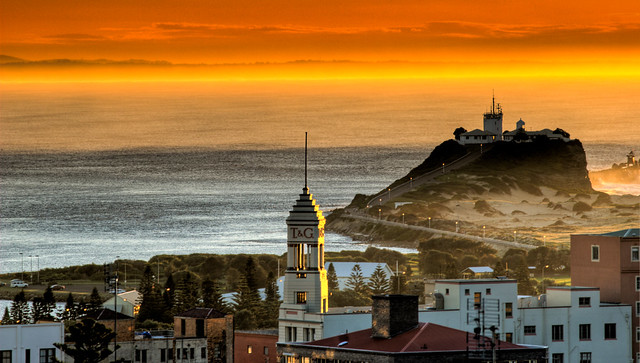 |
| Nobbys lighthouse on the point at Newcastle, NSW Roanish |
 |
| Royal Theatre Newcastle, NSW, Australia opened in 1927 |
 |
| The Clarendon Hotel at Newcastle, NSW, (1930 and rebuilt 1941), Morpeth House 1936 and the Fred Ash building 1855 |
 |
| The original Great Northern Hotel existed on this site since 1863, Newcastle, NSW |
 |
| The Victoria Theatre in Newcastle, New South Wales, opened 1876 and rebuilt during 1890-91. In a sad state. |
 |
| Building in Telford Street, Newcastle, NSW |
 |
| Earp Gilliam Bond Building, built in 1888, Newcastle, NSW |
 |
| Wood's Chambers, later called the Longworth Institute, built in 1892, Newcastle NSW |
 |
| Newcastle's iconic hotel, Star Hotel, circa 1925, Newcastle NSW |
 |
| Crn Hunter St, cnr Bolton Street, Commercial Banking Company of Sydney, Newcastle NSW |
 |
| Union Steam Ship Company at No. 31 Watt Street, Art Deco exterior, circa 1930s |
The Union Steam Ship Company at No. 31 Watt Street is a heritage protected building which was erected in the 1930s on the site of convict barracks built in the 1820s. Watt Street, which is Newcastle's oldest street, was once the centre of shipping agents. The oldest shipping agent was John Reid Pty Ltd established in 1862. Read
here. In the 1820s Henry Dangar, the government surveyor, conducted a town plan and laid out the town grid. Watt Street was one of the only original streets to remain.
Newcastle NSW
 |
| Watt Street, Newcastle, Newcastle, NSW |
 |
| Newcastle Museum, NSW. Was the Honeysuckle Point Railway Workshops, designed by John Whitton and built from 1874 to 1886 |
 |
| King Street, Newcastle West, Newcastle NSW |
 |
| Newcomen Street, Newcastle, NSW, Art Deco building |
 |
| Wolf Street, Hunter Mall, Newcastle, NSW, Art Deco |
 |
| The Central Hall was opened in 1903 and from around 1905, it was used to screen films from travelling picture shows |
 |
| Former National Australia Bank, Inter-War Commercial Palazzo style, circa 1921, Newcastle NSW |
 |
| Hunter Street mall, circa 1920, Newcastle NSW |
 |
| Art Deco building Colonial Mutual Life Insurance, circa 1937, Newcastle NSW |
 |
| NESCA House is located on the corner of King Street and Auckland Street, constructed between 1937 and 1939, Newcastle NSW |
 |
| Heritage building, The Hill, Newcastle, Newcastle NSW |
 |
| Beacon tower, The Hill, Newcastle, NSW. It was built in 1865 to assist captains in bringing their ships safely into the port. More info |
 |
| Jesmond House, an Italianate mansion of the 1880s, Newcastle, NSW. The house was built for Henry Rouse, in 1875, in the Victorian Classical Revival style. It was bought by John Wood, who died in 1887, Newcastle NSW |
 |
| Looking over Newcastle from The Hill, Newcastle NSW |
 |
| The Newcastle Court House was completed in 1892, Newcastle NSW |
 |
| The heritage-listed Civic Theatre was opened in 1929, Newcastle NSW |
 |
| Interior of the Civic Theatre, Newcastle NSW |
 |
| The Captain James Cook Memorial Fountain, constructed in 1966 and officially opened in 1970, Newcastle NSW |
 |
| Fort Scratchley, a former coastal defence installation, is now a museum. It is located in Newcastle East, a suburb of Newcastle, New South Wales in Australia. It was built in 1882 to defend the city against a possible Russian attack, Newcastle NSW |
 |
| Newcastle Ocean Baths, NSW, opened in 1922, Newcastle NSW |
 |
| Sailing at Newcastle, NSW, view of industries |
 |
| View of the town of Newcastle, NSW, from the harbour |
Books to Read
The Restorer, by Michael Sala
A family moves from Sydney to Newcastle, where Roy has bought a derelict house on the coast.
Things To Do and Places To Go
Sir Thomas Mitchells Angular Observations and Field-Note Sketches of Newcastle
Newcastle Military Barracks





.jpg)


























.jpg)



























































































